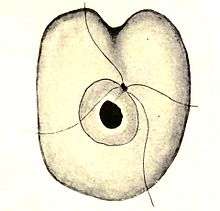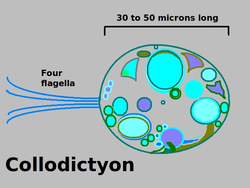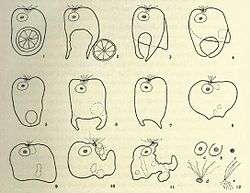Collodictyon
Collodictyon is a genus of single-celled eukaryotes belonging to the collodictyonids, also known as diphylleids. Collodictyonids do not belong to any well-known kingdom-level grouping of that domain.[1] Recent research places them in a new 'supergroup' together with rigifilids and Mantamonas, with the so-far informal name 'CRuMs'.[2]
| Collodictyon | |
|---|---|
 | |
| Collodictyon, with nucleus and four flagella (view from the rear) | |
| Scientific classification (incertae sedis within Eukaryota) | |
| Domain: | |
| Order: | |
| Family: | |
| Genus: | Collodictyon Carter 1865 |
| Type species | |
| Collodictyon triciliatum Carter 1865 | |
| Species | |
| |
Taxonomy and phylogeny
| |||||||||||||||||||||||||||||||||||||||
| Phylogenetic position of Collodictyon relative to a few example organisms[3] |
Three species are currently recognised in this genus. The type species is Collodictyon triciliatum. A second species—Collodictyon sparsevacuolatum—named by Skuja is also recognised; this species is found in freshwater in the United States and Europe. A third species Collodictyon sphaericum has been described but its description is in doubt. A fourth species—Collodictyon hongkongense—has been described by Skvortzow but this description is considered inadequate and this species is regarded as being of dubious validity.[4]
Along with the genus Diphylleia, this organism appears to be only distantly related to the other eukaryotes.[3][5] They share some morphological features with the species currently placed within the Excavata. However this latter clade is considered to be polyphyletic and in need of resolution (reorganisation into different groups). For this reason inclusion of this genus within the excavates may not assist in understanding its phylogenetic position.
Brugerolle has proposed a family, Collodictyonidae for this genus and Diphylleia.[6]
Another genus that is related to Collodictyon is Sulcomonas.
Scientists speculate that further study of Collodictyon may yield insights into the prehistoric beginnings of life hundreds of millions of years ago.[1] Scientists from Norway have been studying a particular type of Collodictyon found living in sludge in Årungen, a lake in the municipality of Ås in Norway.[1][7] Kamran Shalchian-Tabrizi, the leader of the Microbial Evolution Research Group (MERG), has claimed that these organisms resemble the basal eukaryote.[1]
Collodictyonids were placed by Cavalier-Smith in Varisulca[8], but this grouping appears to be paraphyletic.
Description

The species in this genus range in size from 30 to 50 µm in length,[1] can grow broad pseudopodia, and have four flagella[1] and a ventral feeding groove or sulcus.[3] They are devoid of cellulosic cell walls, chloroplasts or stigmata. There are two to several contractile vacuoles.
The cell shape is variable but is mostly obovoid to ellipsoid. The lateral cell margins maybe somewhat angular leading to a broad, truncated rounded apex. This posterior margin narrows posteriorly and either bears 1-3 lobes or is simply broadly rounded. This margin is often pseudopodial.
The nucleus typically lies in the posterior half of the cell.
The mitochondria have tubular cristae.
Organelles called dictyosomes are present and arranged in a horseshoe like shape.[6]
Members of this genus are known to reproduce asexually through cell division. Whether sexual reproduction occurs is currently unknown.
Collodictyon triciliatum has four flagella connected to basal bodies, generally of equal length, as long as or slightly longer than the body of Collodictyon.[9] Number one flagellum is connected to a dorsal root, while number two flagellum is connected to a ventral root. Number three and four flagella are on either side of these two and have dorsal roots.
Distribution
Originally Collodictyon triciliatum was described from the island of Bombay and later in central Europe.[10][11] In Europe this species is found from Spain[12] to Norway.[3] Collodictyon has also been reported in North America.[4][11][13]
Feeding

The feeding habits of this organism have rarely been studied.
In its feeding habits, Collodictyon is most interesting. When hungry, it can be distinguished from moribund stages in which all food is extruded by pseudopial projections from the lateral groove or sulcal region ... these pseudopodia ... function actively whenever the organism is seeking food. At these times when coming in contact with Protozoa or algae which it may use for food, they are wafted to the sulcal region by the flagella, or else Collodictyon aligns itself alongside of its prey with the pseudopodia in contact. ... Both the flagella and the pseudopodia appear sensitive to food stimulus ...
— Robert Clinton Rhodes, 1917[14]
Dag Klaveness reported that the creatures are "not sociable" and will cannibalize each other when food is scarce.[1] Collodictyon will ingest freshwater algae and appears to be unable to survive on a diet of bacteria alone. Curiously the algae remain viable at least for a while after being engulfed. It is possible that the algae are "enslaved".[14]
History
Collodictyon triciliatum was originally named by H. J. Carter in 1865.[10] Carter's original species description is as follows:
Pyriform, straight, or slightly bent upon itself, bifid (two-lobed) at the small extremity, presenting at the larger one an indentation, from which spring three cilia. Structure transparent, cancellated, composed of globular cells, with a strongly marked, greenish granule here and there in the triangular spaces between them. Locomotive, swimming by means of the cilia; subpolymorphic, flexible, yielding, capable of assuming a globular form ... or one more or less modified by the body it may incept . . . ; enclosing crude material for nourishment in stomachal spaces, and ejecting the refuse, like Amoeba. Provided with a nucleus and contracting vesicles.
— Carter, 1865[11]
In 1917, it was classified as being one of the "simplest and most primitive" type of Polymastigina.[15]
References
- "Scientists find 'man's remotest relative' in lake sludge". 26 April 2012.
- Brown, Matthew W; Heiss, Aaron A; Kamikawa, Ryoma; Inagaki, Yuji; Yabuki, Akinori; Tice, Alexander K; Shiratori, Takashi; Ishida, Ken-Ichiro; Hashimoto, Tetsuo; Simpson, Alastair; Roger, Andrew (2018-01-19). "Phylogenomics Places Orphan Protistan Lineages in a Novel Eukaryotic Super-Group". Genome Biology and Evolution. 10 (2): 427–433. doi:10.1093/gbe/evy014. ISSN 1759-6653. PMC 5793813. PMID 29360967.
- Zhao, Sen; Fabien Burki; Jon Bråte; Patrick Keeling; Dag Klaveness; Kamran Shalchian-Tabrizi (2012-01-06). "Collodictyon – an Ancient Lineage in the Tree of Eukaryotes". Molecular Biology and Evolution. 29 (6): 1557–68. doi:10.1093/molbev/mss001. ISSN 0737-4038. PMC 3351787. PMID 22319147. Retrieved 2012-05-02.
- MD Guiry in Guiry MD & Guiry GM 2012. "Collodictyon HJ Carter, 1865: 289". AlgaeBase. World-wide electronic publication. Galway: National University of Ireland. Retrieved 28 April 2012.
- Live Science Strange, Organism Has Unique Roots in the Tree of Life, by Jennifer Welsh, 29 April 2012
- Brugerolle, Guy; Bricheux G; Philippe H; Coffea G (March 2002). "Collodictyon triciliatum and Diphylleia rotans (=Aulacomonas submarina) form a new family of flagellates (Collodictyonidae) with tubular mitochondrial cristae that is phylogenetically distant from other flagellate groups". Protist. 153 (1): 59–70. doi:10.1078/1434-4610-00083. PMID 12022276.
- Yngve Vogt (23 April 2012). "Mankind's remotest relative". Apollon. Original Norwegian press release with pictures of researchers.
- Cavalier-Smith, Thomas; Chao, Ema E.; Lewis, Rhodri (2016-06-01). "187-gene phylogeny of protozoan phylum Amoebozoa reveals a new class (Cutosea) of deep-branching, ultrastructurally unique, enveloped marine Lobosa and clarifies amoeba evolution". Molecular Phylogenetics and Evolution. 99: 275–296. doi:10.1016/j.ympev.2016.03.023. PMID 27001604.
- Rhodes, Robert Clinton (29 October 1917). Binary Fission in Collodictyon tricilliatum. Berkeley, California: University of California.
number of flagella is four (page 238 of original book; page 50 of the pdf file). Flagella are equal in length, as long as the body or possibly longer...
- Carter, H.J. (1865). "XXXII.—On the fresh- and salt-water Rhizopoda of England and India". Journal of Natural History. Series 3. 15 (88): 277–293. doi:10.1080/00222936508681805. ISSN 0374-5481. Retrieved 11 February 2018.
- Rhodes, Robert Clinton (29 October 1917). Binary Fission in Collodictyon tricilliatum. Berkeley, California: University of California.
- Cambra Sánchez, J.; Álvarez Cobelas, M.; Aboal Sanjurjo, M (1988). "Lista florística y bibliográfica de los clorófitos (Chlorophyta) de la Península Ibérica, Islas Baleares e Islas Canarias" (PDF). Asociación Española de Limnología. p. 9. Retrieved 28 April 2012.
- Lackey, James B. (1942-01-01). "The Plankton Algae and Protozoa of Two Tennessee Rivers". American Midland Naturalist. 27 (1): 191–202. doi:10.2307/2421034. ISSN 0003-0031. JSTOR 2421034.
- Rhodes, Robert Clinton (29 October 1917). Binary Fission in Collodictyon tricilliatum. Berkeley, California: University of California.
(page 220 from original book; page 32 from the pdf) ... In its feeding habits, Collodictyon is most interesting. When hungry, it can be distinguished from moribund stages in which all food is extruded by pseudopial projections from the lateral groove or sulcal region ... these pseudopodia ... function actively whenever the organism is seeking food. At these times when coming in contact with Protozoa or algae which it may use for food, they are wafted to the sulcal region by the flagella, or else Collodictyon aligns itself alongside of its prey with the pseudopodia in contact. ... Both the flagella and the pseudopodia appear sensitive to food stimulus ...
- Rhodes, Robert Clinton (29 October 1917). Binary Fission in Collodictyon tricilliatum. Berkeley, California: University of California.
(page 239 of original book; page 51 of pdf file) ... Collodictyon is "one of the simplest and most primitive of the Polymastigina"...
See also
| Wikimedia Commons has media related to Collodictyon. |